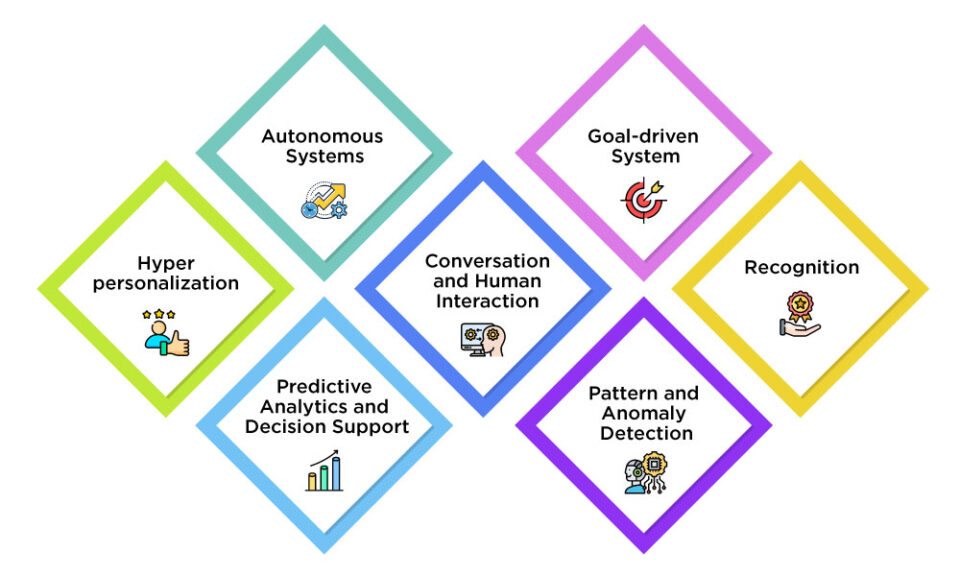Artificial Intelligence (AI) has evolved significantly over the years, divided into various specialized domains. While many are familiar with traditional AI applications like chatbots and recommendation systems, there are some other advanced concepts that are reshaping industries. In this blog, we will delve into seven key AI concepts: hyper-personalization, patterns and anomalies, autonomous systems, goal-driven systems, predictive analysis and decision-making, conversation and human interaction, and recognition. Let’s learn to identify the different ways of each pattern by understanding how they are used and the problems related to them.
The Seven Patterns of AI Are as Follows

Hyper-personalization:
Hyper-personalization has taken personalization methods to the next level. It uses artificial intelligence, machine learning, and advanced algorithms to develop a unique profile of each individual. It treats each customer as an individual.
Hyper-personalization learns about a specific profile and uses it in future for a variety of purposes. That may include personalized recommendations of relevant products and guidance, displaying relevant content, providing personalized suggestions for healthcare, finance, and many more. It also provides information, feedback, and advice.
For example, Netflix uses hyper-personalization to recommend shows. It uses data by checking customers browsing history and by analyzing their preferences. As per the report, hyper-personalization is expected to boost their revenue by 10-15% for businesses that effectively implement it.
Autonomous Systems:
It represents an important rise in AI capabilities and takes decisions independently. The primary objective of autonomous systems is ‘minimize human labor’. These systems perform a specific task without any human involvement. This works on hardware autonomous systems and software (Virtual) autonomous systems.
Predictive Analytics and Decision Support:
Predictive analysis involves using historical data and statistical algorithms to forecast future outcomes by using machine learning and other approaches. It helps humans to make better decisions regarding future results by using insights that it learns from interaction, provided data, and behavior. Its main objective is to help humans and systems make better decisions.
Predictive analytics can be performed without using artificial intelligence. In this pattern machines help humans to make better decisions, and such cases are also called augmented intelligence. For example, Amazon uses predictive analysis to improve inventory management and predict customer demand for products.
Conversation and Human Interaction:
In this pattern, machines interact with humans through natural interaction and conversation that includes image, write-ups, voice, and text forms. The objective of this pattern is to enable communication and interaction between machines and humans or between humans. This includes machine to human, human to machine or human to human interactions.
Conversation and human interaction do not involve machine to machine interaction, as machines do not use human forms of communication. For example, OpenAI’s ChatGPT is an advanced conversational AI that is capable of engaging users in meaningful machine-human conversation.
Pattern and Anomaly Detection:
AI is capable of recognizing patterns within vast datasets, and it plays an important role in anomaly detection. In this type of pattern, machine learning and other approaches are used to detect patterns in data. The main objective of this pattern is to search for which things are similar to each other and which are not. It is used to find exceptional things and anomalies in data. For example, fraud detection and risk analysis.
Recognition:
It identifies and classifies objects, patterns, or features within data, such as video, audio, and images. This pattern is used widely. It is a well-developed pattern designed to identify objects, such as image and object recognition, gesture detection, facial, sound, or voice recognition. The primary objective of this pattern is to identify machines and understand things.
For example, Apple's Face ID technology uses facial recognition to unlock devices securely. As per report, in 2023, the global facial recognition market was valued at approximately USD 6.3 billion, with a projected growth rate of over 16.3% CAGR through 2030, highlighting the increasing adoption of recognition technologies across various sectors.
Goal-driven System:
This is the final pattern of AI. It is designed to achieve specific objectives by making proper planning and reasoning. Its objective is to find optimal solution to a problem. For example, in 2023, Spot was deployed in various industries to demonstrate the effectiveness of goal-driven AI systems, to enhance operational efficiency.
Combining Multiple Patterns in a Project
There are some projects in which only a single pattern is used but, in some projects, multiple patterns are used or combined together to realize their goal. This gives a better approach and executes AI projects effectively.
Summarizing!
As AI continues to advance, the above-mentioned AI patterns highlight their transformative possibilities across industries. From hyper-personalization to autonomous systems, AI is not just about automation. It is about enhancing human experiences, improving decision-making, and driving innovation and communication between machines and humans. The adoption of these AI concepts will be important for businesses.
By leveraging these technologies, organizations can improve efficiency and create more engaging and personalized experiences for their customers. The future of AI is bright for businesses that adapt to these advancements and lead the way in their respective industries.
To know more visit us at WisdomPlexus!
Recommended For You:




